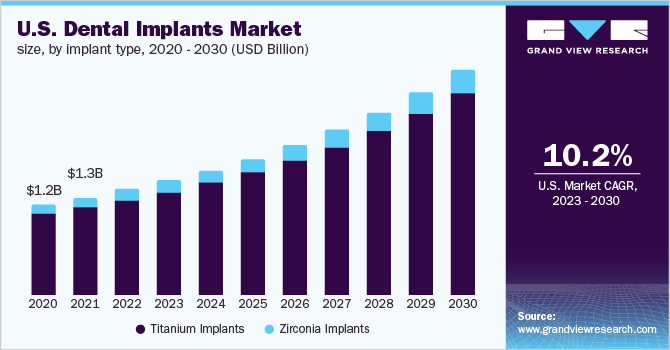
Millions of dental implants are placed worldwide each year, showcasing the growing popularity of this innovative tooth replacement solution. This number attests to the success and demand for dental implant procedures. Renowned for their natural appearance and durability, dental implants have become a game-changer in dentistry, providing individuals with a reliable and long-lasting means of restoring smiles and enhancing oral health. If considering dental implants, rest assured that you’re not alone; countless people have found renewed confidence and an improved quality of life through this widely embraced tooth replacement option.

How Many Dental Implants Are Placed Each Year?
Dental implants have become increasingly popular in recent years as a solution for missing teeth. Many people opt for this procedure due to its durability, natural appearance, and ability to restore proper function to the mouth. But have you ever wondered how many dental implants are placed each year? In this article, we will explore the statistics and trends surrounding dental implant placement.
The Rise of Dental Implants
Historical Shift
- Past Solutions: Dentures and dental bridges were traditional choices for tooth replacement.
- Challenges: Discomfort, limited functionality, and frequent replacements were common issues.
- Permanent Solution: Dental implants emerged as a more permanent and long-lasting alternative, mimicking the look and feel of natural teeth.
How Many Dental Implants Each Year?
Varying Factors
- Geographic Variation: Numbers depend on factors like location, population size, and dental care access.
- American Statistics: According to the American Academy of Implant Dentistry, approximately 3 million people in the U.S. have dental implants, with an estimated 500,000 new implants annually.
The Benefits of Dental Implants
Permanence and Durability
- Lifetime Solution: Dental implants, unlike dentures or bridges, can last a lifetime with proper care.
- Surgical Placement: Surgically anchored in the jawbone for a strong and stable foundation.
Natural Appearance
- Custom Prosthetics: Implants offer a natural look, with custom-made teeth matching color, shape, and size.
- Secure Fit: Unlike dentures, implants stay securely in place, enhancing confidence in speaking, eating, and smiling.
Oral Health Maintenance
- Preventing Misalignment: Implants prevent surrounding teeth from shifting or tilting, preserving proper bite alignment.
- Stimulation of Jawbone: Implants stimulate the jawbone, preventing bone loss and preserving facial structure.
The Impact of Dental Implants
Restoring Confidence
- Recovery from Tooth Loss: Dental implants help restore smiles and confidence for those who lost teeth due to injury, decay, or other factors.
- Enhanced Quality of Life: Comfortable eating, speaking, and improved appearance contribute to an improved quality of life.
Positive Oral Health Effects
- Maintaining Alignment: Implants contribute to proper bite alignment, reducing the risk of gum disease, tooth decay, and jawbone deterioration.
Factors Influencing Placement
Technological Advancements
- Improved Accessibility: Advancements in dental technology and techniques have made implant placement more accessible and efficient.
- Enhanced Skills: Dentists and oral surgeons’ refined skills in implantology result in improved success rates and shorter recovery times.
Growing Awareness
- Patient and Professional Awareness: Increased awareness of implant benefits among both patients and dental professionals contributes to their popularity.
- Long-Term Solutions: Dental implants have become the treatment of choice for individuals seeking lasting solutions for tooth loss.
In conclusion, dental implants have become a popular and effective solution for tooth loss. With millions of implants placed each year, the impact of this procedure on oral health and overall well-being is significant. The rise of dental implants can be attributed to their durability, natural appearance, and ability to maintain oral health. As technology continues to advance and awareness grows, the number of dental implants being placed each year is likely to increase, providing more individuals with a long-lasting solution for missing teeth.
Key Takeaways: How Many Dental Implants Are Placed Each Year?
- Millions of dental implants are placed worldwide every year.
- In the United States alone, over 5 million dental implants are placed annually.
- Dental implants have a high success rate, with over 95% success in most cases.
- The number of dental implants placed each year is increasing due to advancements in technology and techniques.
- Dental implants are a popular solution for replacing missing teeth because they provide stability and functionality.
Frequently Asked Questions
Curious about the number of dental implants placed each year? We’ve got you covered. Read on to find answers to some commonly asked questions about the annual placement of dental implants.
Question 1: What is the approximate number of dental implants placed globally each year?
Each year, an estimated 5 million dental implants are placed worldwide. This number continues to grow as more people realize the benefits of dental implants for replacing missing teeth. Dental implant placement has become a popular and successful solution for restoring oral health and enhancing smiles.
Dental implant procedures have advanced significantly over the years, making them a reliable and long-lasting option for tooth replacement. With advancements in technology and improved success rates, the number of dental implants being placed annually is expected to continue increasing.
Question 2: How many dental implants are placed in the United States each year?
In the United States alone, approximately 500,000 dental implants are placed each year. This number showcases the growing demand for dental implant treatments as more individuals seek a permanent solution for missing teeth. Dental implants offer numerous advantages over traditional tooth replacement options, such as bridges or dentures, which contribute to their popularity.
As dental implant technology continues to improve and become more accessible, it is anticipated that the number of implants placed in the United States will continue to rise in the coming years.
Question 3: Are dental implants more common in certain age groups?
Dental implants are suitable for individuals of various age groups who have lost teeth due to various reasons. While dental implants are commonly associated with older adults, they are increasingly becoming popular among younger individuals as well. Age is not a significant deciding factor for dental implant candidacy, as long as the patient has good overall oral health and sufficient bone density to support the implant.
With advancements in dental implant technology and a greater awareness of their benefits, people of all ages are opting for dental implants as a reliable and permanent solution for missing teeth.
Question 4: Are dental implants a common choice for full mouth reconstruction?
Yes, dental implants are often used for full mouth reconstruction procedures. Full mouth reconstruction involves the replacement or restoration of all teeth in the upper and lower jaws. Dental implants are considered the gold standard for full mouth reconstruction as they provide a stable and long-lasting foundation for prosthetic teeth.
Full mouth reconstruction with dental implants can improve oral function, aesthetics, and overall quality of life for individuals with extensive tooth loss or severe dental issues.
Question 5: Are there any factors that may affect the number of dental implants placed each year?
Several factors can influence the number of dental implants placed each year. These factors include advancements in dental implant technology, accessibility to dental implant procedures, affordability, and increased awareness of the benefits of dental implants.
Additionally, factors such as oral hygiene practices, tooth loss rates, and the prevalence of dental conditions can also impact the demand for dental implant placement. As dental implant procedures continue to evolve and become more widespread, it is anticipated that the number of implants placed each year will continue to increase.
Dental Implant Procedure – Two Stage Award Winning Patient Education
Final Summary: How Many Dental Implants Are Placed Each Year?
Millions of dental implants are placed globally each year, reflecting the increasing popularity of these long-lasting tooth replacements. In the United States, over 5 million implants are estimated annually, a staggering figure that mirrors the global trend. Countries like Germany, Brazil, and Japan also report significant numbers of dental implant procedures. The widespread appeal of implants lies in their ability to restore natural tooth functionality, boost confidence in eating and speaking, and enhance smile aesthetics. With a design for a lifetime, dental implants are considered a wise investment in oral health, making them a transformative solution embraced by millions worldwide.
Call or Book appointment online
:Ace Dental Care Alpharetta office: 678-562-1555 - Book Now
Ace Dental Care Norcross office: 770-806-1255 - Book Now
Disclaimer
This blog post was generated by artificial intelligence. The content of this post may not be accurate or complete, and should not be relied upon as a substitute for professional advice. If you have any questions about the content of this post, please contact us.
We are constantly working to improve the accuracy and quality of our AI-generated content. However, there may still be errors or inaccuracies. We apologize for any inconvenience this may cause.





